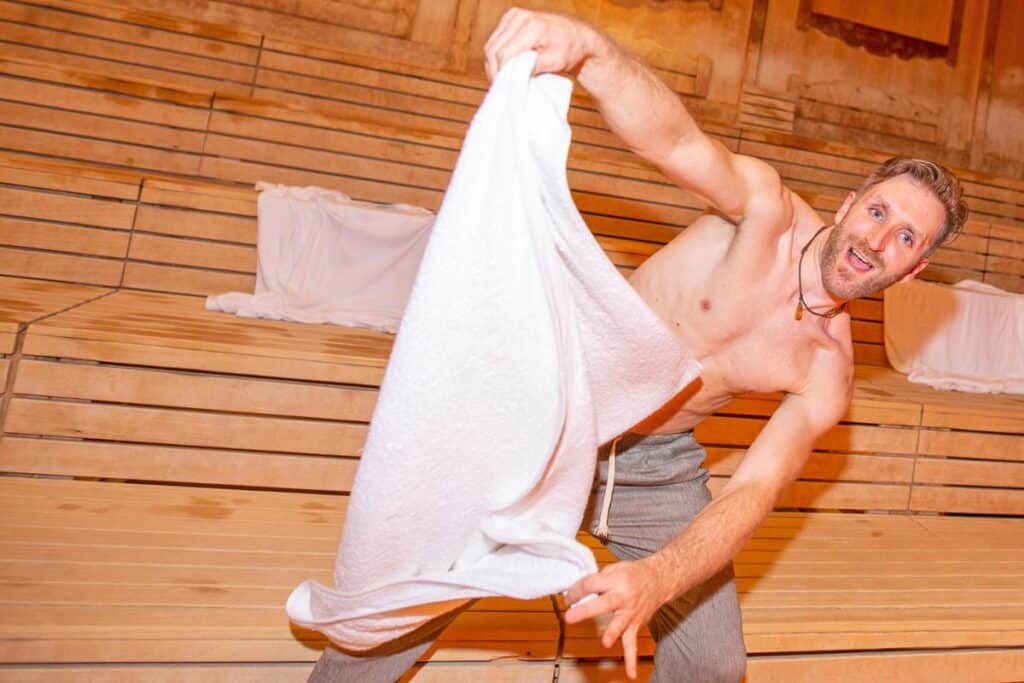Attending a Aufguss World Championship (Aufguss WM) for the first time can be intimidating, especially if you come from the United States, where sauna culture is just taking off. Very recently, new spas with large-format event saunas for aufguss rituals have opened in New York (Othership and Bathhouse) and Las Vegas (Resorts World and Fontainebleau), with more to come.
However, at Thermen Bussloo, an impressive sauna and wellness centre near Amsterdam in the Netherlands, we are surrounded by hundreds of partially naked sauna enthusiasts who have paid €100 for a daily ticket to embark on a journey full of emotions, art and warmth.

The basics
The word "aufguss" is the first thing a novice should understand. This German word translates as "steam infusion", but has become a generic term to describe the 15-20 minute experience that a sauna master or aufguss guides you through.
The aufguss comes in many different forms. Classic sessions, which have been practised for decades throughout Europe, see the role of the sauna master as raising the temperature and controlling the circulation of steam, heat and aromas through the creative movement of towels. Ritual (or zen) aufguss sessions take guests on an inner journey, including meditation, yoga, sound baths or breathing exercises. Whereas theatrical or show aufguss sessions, the focus of Aufguss WM, are best described as an emotionally driven journey of purely performing art.

The "stage" for the shows is the new 2 million Euro Sauna Theatre in Thermen Bussloo, built specifically to stimulate the senses with state-of-the-art lighting and sound systems and an LED screen over 4.5 m wide. With 160 participants, the championships attract the best aufguss masters in the world and I can confirm that a 15-minute session in a sauna at 80°C has never been so appealing.
The next thing that comes to mind is the almost total nudity in the sauna, except for the performer herself and those of us with judiciously placed towels. Nudity makes sense when you're in the moment (sweat and clothes don't mix well), but this (mainly European) practice is initially off-putting. However, I take it as an opportunity to celebrate cultural differences and embrace body positivity.

Competition time
Over the five days of the Aufguss WM, 16 sessions are held daily, with qualifiers from the 16 participating countries taking part in the individual and team competition. A jury meticulously scores each round, narrowing the qualifiers down to 16 finalists who will compete for the title of world champion on the last day.
Aufguss masters are judged on multiple aspects: from professionalism to the ability to build up and distribute heat, towel-waving techniques (with deductions for dropping a towel), theme and implementation (does the theme make sense? Is the audience involved?), atmosphere and overall feel, and team coordination (including performance preparation, which is kept to a strict 15-minute deadline).

The championships have been running since 2015 and next year there will be even more competitors, as three new countries (Canada, Iceland and the USA) will launch national qualifying events.
Attending the final sessions as the sauna masters competed for first place, I was impressed by the level of detail and performance. Itsuki Minotani, a newcomer from the Japanese team, took us into his virtual reality world as he fell in love with a virtual girlfriend, and took us on a journey of first dates and kisses with exceptional towel movement. Barbora Brozova, a Czech trained dancer, beautifully strolled through the sauna as she told the story of a loss and the power of following a dream.
This year's winner, Italy's Michael Niedermair, brought tears to my eyes as he beautifully explored the struggle many young people today are experiencing with depression and mental illness. It was his fourth time in the final, but his first win. "My goal with an aufguss is always to send a message," she exclaims. "When you fall, accept it, accept yourself and move on."




